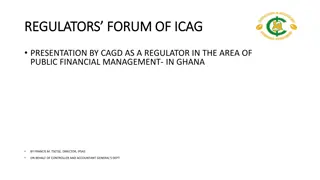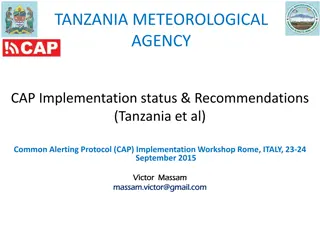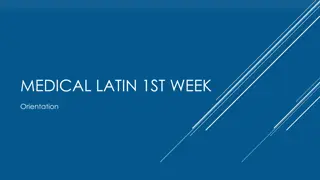Status of IPSAS Implementation in Latin American Countries
This report discusses the status of IPSAS implementation in Latin American countries as of July 27-29, 2016, with details on the objectives of the study, participating countries, methodology, and next steps. It also highlights the strategies of the Inter-American Development Bank (BID) to support the use of national systems for better financial management and transparency.
Download Presentation

Please find below an Image/Link to download the presentation.
The content on the website is provided AS IS for your information and personal use only. It may not be sold, licensed, or shared on other websites without obtaining consent from the author.If you encounter any issues during the download, it is possible that the publisher has removed the file from their server.
You are allowed to download the files provided on this website for personal or commercial use, subject to the condition that they are used lawfully. All files are the property of their respective owners.
The content on the website is provided AS IS for your information and personal use only. It may not be sold, licensed, or shared on other websites without obtaining consent from the author.
E N D
Presentation Transcript
Status of IPSAS implementation in Latin American countries 27, 28 y 29 de julio de 2016 Sheraton Asunci n Hotel
Agenda 1 Introduction 2 Objectives of the study 3 Participating countries 4 Overall survey approach 5 Methodology of the gap analysis 6 Methodology of the interviews on IPSAS related benefits 7 Planned layout of the presentation of results 8 Timeline and status of the project 9 Next steps
Estrategia del BID para el Uso de Sistemas Nacionales Estrategia del BID para el Uso de Sistemas Nacionales 1 Mejor ejecuci n y supervisi n de las operaciones 2 Ahorros por la reducci n de costos de transacci n 2016 3 Sinergias estrat gicas y t cnicas 2014 4 Eliminaci n de las duplicidades 2011 Alianza Global para la Cooperaci n Eficaz al Desarrollo Alianza de Busan 2010 Estrategia BID Uso de Sistemas Nacionales 1 Mayor conocimiento y gesti n de la informaci n Agenda de Acci n de Accra 2 Eficiencia, eficacia y transparencia en el uso de los recursos Fortalecimiento y reconocimiento de las capacidades t cnicas y estrat gicas del pa s 2008 3 Establecimiento de est ndares de desempe o conforme a las mejores pr cticas internacionales 4 Declaraci n de Par s 2005 5 Modernizaci n de los sistemas de gesti n y rendici n de cuentas
Reporte Uso de Sistemas Nacionales Reporte Uso de Sistemas Nacionales
Recursos BID apoyo a pases miembro para fortalecer el Recursos BID apoyo a pa ses miembro para fortalecer el Uso de Sistemas Nacionales Uso de Sistemas Nacionales En los ltimos En los ltimos 5 a os miembros del BID por aproximadamente miembros del BID por aproximadamente US$ 6 millones 5 a os el BID ha financiado recursos a los pa ses el BID ha financiado recursos a los pa ses US$ 6 millones. . En los ltimos En los ltimos 2 a os NICSP NICSP 2 a os aproximadamente aproximadamente USD 650 mil USD 650 mil en materia de en materia de
Determine the status of IPSAS adoption on central government level in selected Latin American and Caribbean countries. 1 Explain the benefits of its implementation to policy makers and government officials who are not accountants or practitioners. 2
Honduras Brazil Mexico Chile Nicaragua Colombia Panam Costa Rica Paraguay Dominican Republic Peru Ecuador Uruguay El Salvador New Zealand Guatemala 15 FOCAL member countries participate based on a voluntary decision. New Zealand was chosen as a reference basis.
Structured interviews on reform progress and level of IPSAS alignment to be held with the Accountant General / Ministry of Finance (gap-analysis) 1 Semi-structured interviews on IPSAS related benefits to be held with selected national key stakeholders and international development aid organizations 2
Gap analysis A gap analysis aims to express the proximity of the national accounting framework with the accrual basis IPSAS in percentage terms. This approach allows comparing the national accounting practices at an international level. General questions on the maturity of the current national accounting practices are added to better understand country specifics (not included in the assessment of the alignment level). The gap analysis is performed for the following standards: Presentation and Disclosure IPSAS 01 Presentation of Financial Statements IPSAS 02 Cash Flow Statements IPSAS 03 Accounting Policies, Changes in Estimates and Errors IPSAS 18 Segment Reporting IPSAS 24 Presentation of Budget Information in Financial Statements Major Liabilities: Recognition and Measurement IPSAS 19 Provisions, Contingent Liabilities and Contingent Assets IPSAS 25 Employee Benefits IPSAS 29 Financial Instruments: Recognition and Measurement Revenue IPSAS 23 Revenue from Non-Exchange Transactions (Taxes and Transfers) Major Assets: Recognition and Measurement IPSAS 11 Construction Contracts IPSAS 17 Property, Plant and Equipment IPSAS 21 Impairment of Non-Cash Generating Assets IPSAS 32 Service Concession Arrangements: Grantor Consolidation IPSAS 06 Consolidated and Separate Financial Statements IPSAS 07 Investments in Associates IPSAS 08 Joint Ventures
Calculation of the level of alignment per IPSAS Three answer categories are provided for the analysis of the proximity to IPSAS. The underlying assumption to calculate the level of alignment is as follows: Different = 0% Similar = 50% Identical = 100% In a first step all questions are weighted equally. In a second step, to avoid a pre-dominance of questions related to disclosures, the IPSASs are clustered into sub-categories. The level of alignment is the average of those predefined categories. Recognition Different Measurement Similar Example for a level of alignment of 75% to IPSAS 19 Disclosures Identical 0% 20% 40% 60% 80% 100% Disclosures Measurement Recognition Different Similar Identical 10% 0% 0% 80% 50% 0% 10% 10 questions > N of tickmarks to be devided by 10 50% 4 questions > N of tickmarks to be devided by 4 100% 2 questions > N of tickmarks to be devided by 2
Calculation of the overall level of alignment A weighting factor in a range from 1 to 5 is applied to the degree of alignment per individual standard when calculating the overall alignment level. This weighting factor reflects the relative importance of the standard compared to others in terms of reporting, the significance of the balance sheet position concerned and the fact if the standard is applicable to all or only a limited number of public sector entities. Selected accounting areas IPSAS 1 IPSAS 2 IPSAS 3 IPSAS 18 IPSAS 24 IPSAS 11 IPSAS 17 IPSAS 21 Factor 5 4 2 1 3 1 5 3 Selected accounting areas IPSAS 32 IPSAS 19 IPSAS 25 IPSAS 29 IPSAS 23 IPSAS 6 IPSAS 7 IPSAS 8 Factor 4 4 5 3 5 4 2 3
Example: calculation of the overall level of alignment Accounting areas IPSAS 1 IPSAS 2 IPSAS 3 IPSAS 18 IPSAS 24 IPSAS 11 IPSAS 17 IPSAS 21 IPSAS 32 IPSAS 19 IPSAS 25 IPSAS 29 IPSAS 23 IPSAS 6 IPSAS 7 IPSAS 8 Alignment per IPSAS 100% 70% 60% 0% 100% 0% 50% 80% 10% 90% 30% 20% 30% 100% 100% 100% Factor 5 4 2 1 3 1 5 3 4 4 5 3 5 4 2 3 54 Subtotal 500% 280% 120% 0% 300% 0% 250% 240% 40% 360% 150% 60% 150% 400% 200% 300% 3350% Overall level of alignment: 3350%/ 54 =62% Subtotal
Methodology of the interviews on IPSAS related benefits
Methodology of the interviews on IPSAS related benefits Semi-structured interviews with development aid agencies and national stakeholders regarding IPSAS related benefits on donor projects and economic development. Designing the questionnaire, we first developed basic assumptions, which cover certain theoretical benefits related to IPSAS. With the help of the questionnaire these assumptions will either be confirmed or rejected. There is space offered for additional benefits not yet covered by our assumptions. On the one hand this approach ensures that all aspects are considered that we assume being important. On the other hand it provides a structure which facilitates the analysis of the interviews and to derive statements and conclusions. The interview partner will also be asked to make a ranking of the assumptions according to his / her personal perception of the importance and feasibility of the described benefits.
Online questionnaire (Extract 1)
Online questionnaire (Extract 2)
Planned layout of the presentation of results
Presentation of results in the individual country reports: Gap Analysis: Major Liabilities IPSAS 19 Provisions, Contingent Liabilities and Contingent Assets Recognition Different Measurement Similar Disclosures Identical 0% 20% 40% 60% 80% 100% Please, briefly comment on the table above and specify detected differences. This illustration visualizes the source of the identified gaps. For example: If the adoption of disclosures is scheduled at a later stage of a reform process and currently the government focusses on recognition and measurement of provisions, this will be reflected in the chart and included in the comments on the table.
Presentation of the overall level of alignment with IPSAS: X % - Y % of alignment with IPSAS X % - Y % of alignment with IPSAS X % - Y % of alignment with IPSAS Any main country specific circumstances with a major influence on the implementation of IPSAS will be described in the country report (attachment) and will also be reflected in the analysis of the overall results (main report). We plan to comment on the main source of gaps between national and international standards - especially on the fact whether those gaps are temporary (transitional provisions).
Presentation of the alignment per IPSAS and comparison amongst countries (The images are not based on actual results)
Project Timeline Preparation of the survey Preparation of the survey Quality check of local survey results Coordination and status reports Core Team Analysis of results and draft overall report Teams Local Validation by government Interview, draft country report Phase 3 (2 months) Phase 1 Phase 2 (2 months) Deliver July 31 June 1 September 30 Delivery of country report and survey results Delivery of the draft overall report Kick-off Calls with local teams
Translation of the validated country reports Consolidation, comparison and analysis Draft of the overall report Analysis of the interviews on benefits Draft of papers on IPSAS related benefits Delivery of the draft report to IDB on 30 September 2016.























